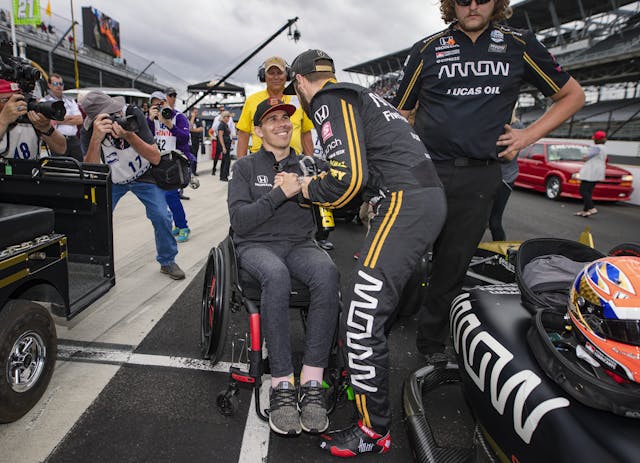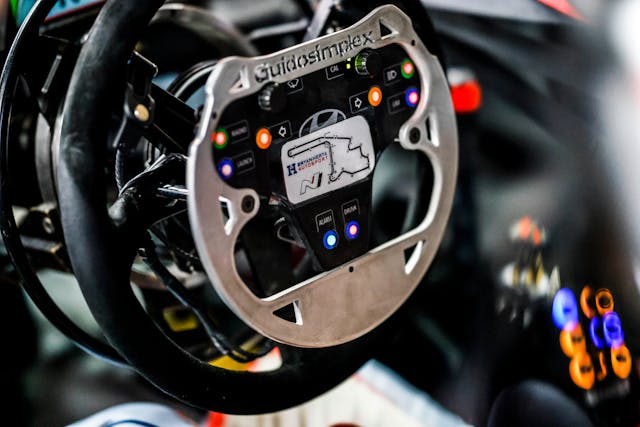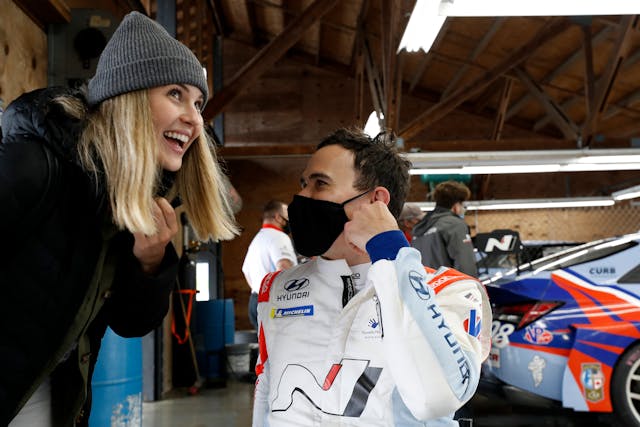Paralyzed in 2018, Robert Wickens has grit, heart, and unfinished business in motorsports
Odd: Robert Wickens, who had never raced in IndyCar, and had never driven on the 1.8-mile, 14-turn street course at the Grand Prix of St. Petersburg before, went out late and knocked the seven-time polesitter Will Power off the top starting spot. On a drizzly day, on a slick track.
Yet he seems strangely calm—no giddiness, no I-can’t-believe-this-just-happened. There is the occasional flash of his goofy Howdy-Doody grin, but for the most part rookie Wickens is all business. He says the right things, but his eyes show that he is not nearly surprised as the rest of us. “Just doing my job,” Wickens says.
For one thing, “It feels strange to be called a rookie.” Yes, he has never raced an IndyCar before, but he’s 28, an age when most IndyCar drivers already have five years in the seat. But the Guelph, Ontario native has been working toward this day almost all his life—at age 10, he told his parents that he was going to be a professional race car driver—and if you’ve never heard of him, it isn’t because he hasn’t been out there, racing something, somewhere. Mostly in Europe, where he chased the dream of so many young North American racers to make it to Formula 1. He made it to the role of reserve driver for Virgin Racing, but reserve driver is not the same as driver, and Wickens knew that was as close as he was going to get.
He started out, of course, in karts, and moved to Formula BMW, then Champ Car’s Atlantic series, then Formula Renault 3.5, then Formula 3 Euro, FIA Formula 2, GP 3, then back to Formula Renault 3.5, where he was the season champion. That was in 2011. In 2012, when it appeared F1 was indeed an unfulfilled dream, Wickens began driving, for the first time, cars with roofs on them—the DTM series, driving for Mercedes.

In June of 2017, in what amounted to a tryout, he practiced in a Schmidt Peterson Motorsports IndyCar at Road America’s Kohler Grand Prix, because regular driver Mikhail Aleshin had competed in the 24 Hours of Le Mans and couldn’t get back through immigration to Wisconsin in time. Later than year, it was announced that Wickens would join Schmidt Peterson full-time in 2018.
And March 10, 2018, Wickens put his Schmidt Peterson Honda on the pole at St. Petersburg. In the race, he led almost every lap until two from the end, when the ever-aggressive Alexander Rossi made a move to pass and crashed them both. Without that, there’s little question Wickens would have won his very first IndyCar race. He finished 18th.
But he continued to threaten for the win. In the next dozen races he finished second twice, with a total of seven top-five finishes. With three races to go, he had already scored enough points to make him the IndyCar Rookie of the Year, and his ninth-place finish in his first Indianapolis 500, in which he led two laps, gave him that ROTY award, too.

Then, Pocono, a track that has had a cloud over it since the freak death of Justin Wilson in 2015, who died when debris from Sage Karam’s wrecked car soared into the air and came down into Wilson’s cockpit.
On August 19, 2018, Pocono would be the race that changed everything for Robert Wickens. On lap seven, Wickens and Ryan Hunter-Reay were going for the same real estate when they touched wheels, launching Wickens over Hunter-Reay’s car into the catchfence, shearing off all four wheels and most of the bodywork before Wickens, still in the IndyCar pod, hit the pavement. His car spun at least 14 times.
Wickens was alive, surprisingly so because the crash looked so much like Dan Wheldon’s fatal trip into the fence at Las Vegas. In fact, Wickens was “awake and alert,” it was reported. Not reported, and not known until after he had been helicoptered to the hospital, was that his spine was damaged. Not severed, but damaged. He was paralyzed from the waist down.
That wasn’t all, by any means. His family said that Wickens had suffered a thoracic spinal fracture, a neck fracture, tibia and fibula fractures to both legs, fractures in both hands, a broken right forearm, a broken elbow, four broken ribs, and a pulmonary contusion. Because he was an athlete, recovery came more quickly than expected, but not fast enough for Wickens.

“I need to be on my feet for my wedding,” Wickens told NBC in an interview that aired before the St. Petersburg race in March of 2019. “And it isn’t that far away. I’m getting married in September.” As always, Wickens was even competitive in rehab: “I want to have the best spinal cord recovery in the history of spinal cord recoveries,” he said. “I want to recover and get back to life the best that anyone has ever done.
“I don’t care how hard I have to work,” he said. “I’m going to come back.”
With help, he did manage to stand for his wedding to Karli, attended by friends like James Hinchcliffe, Marco Andretti, and Graham Rahal and his wife, Courtney Force.
But since then, there haven’t been many videos of his recovery. Barring a massive breakthrough—which could certainly come, given the fact that Wickens is just 32—“I’m probably going to be in a wheelchair for the rest of my life,” he said on May 4. But that was also the day that Wickens took a huge step in his promise to make a comeback. A massive step.
***
Two months ago, IndyCar winner Bryan Herta, father of driver Colton Herta, who won the St. Petersburg opener this year, called Wickens and asked if he would be interested in driving a race car. Of course! Wickens replied.

Herta owns Bryan Herta Autosport, a collection of Hyundai Veloster and Elantra TCR cars that race in the IMSA Michelin Pilot Challenge series, which runs as an opening act to the IMSA WeatherTech Championship, the same cars that race in the Rolex 24 at Daytona.
The Michelin Challenge series consists of two classes—Grand Sport, or GS, consists of GT4 racers like the McLaren 570S, Porsche Cayman, BMW M4, and Audi R8. The Touring Car, or TCR class, has cars like the Veloster N, the Hyundai Elantra, Audi RS3, Honda Civic FK7, and the Alfa Romeo Giulietta.
One of Herta’s Velosters, operated by Michael Johnson Racing, has hand controls, as Johnson is paralyzed from the chest down. Now 28, like Wickens when he had his crash, the Michigander was just 12 when he crashed as he was going for the lead in a dirt track motorcycle race. He broke his collarbone, right ribs, left ankle, and left leg. He also fractured the T5 and T6 vertebrae in his back, which caused the paralysis. He currently has four rods and 15 screws in his back, after undergoing an 11-hour surgery.
Johnson and codriver Stephen Simpson, who uses conventional controls in the car, have been driving partners for six seasons. They won a TCR race at Lime Rock Park in Connecticut in July of 2018, coming off a broken leg Johnson suffered in a crash at Daytona International Speedway. This year, Johnson and Simpson notched a fifth-place finish at Daytona in the IMSA Michelin Challenge series, the second-highest performance of the seven Hyundais in the race.
So with that in mind, along with Johnson’s and Simpson’s permission, might it be possible for Robert Wickens to test the car? After all, Hyundai had booked the Mid-Ohio Sports Car Course for the day on May 4, in preparation for the race there this Saturday.
Johnson and Simpson said yes, Wickens said yes, so it was up to Herta to do the rest.
You’d think hand controls would be pretty standardized—after all, racers like Alex Zanardi and 22-year-old Billy Monger who, like Zanardi, isn’t paralyzed but lost his legs in a racing crash have driven competitively and won races with hand controls.

But, Herta learned, there are hand controls and there are hand controls.
Since Johnson is paralyzed from the chest down, his hand controls, which he helped design, are specifically made for his capability. They consist essentially of a round aluminum ring behind the steering wheel, and in front of the steering wheel. Press the front ring to go, pull the rear ring to stop. Transmission is sequential and you only need the clutch for launch, and that’s actuated by a big lever to the driver’s right.
After the first session on the track, after Simpson set a baseline, “It’s been going really well,” said the soft-spoken Johnson. “He’s getting comfortable, then the damp weather threw him a curveball.
“The car is fantastic for me, but that doesn’t mean it will be for Michael. He knows what he’s doing, it’s just a matter of learning the system.”
“Robert is a pro,” Herta said. “There’s no doubt he went through that washing machine in Europe, all the good and the bad, as he chased Formula 1. But he ended up being very successful in DTM, and he decided he wanted to be an IndyCar driver, and he was well on his way to being a major star in the sport.

“Now, in typical RW fashion, he’s taking on his recovery as a personal challenge. It’s inspirational how he is working so hard on his recovery, and we’re proud to offer him his first time back in a car. It’s an honor for us.
“His focus, determination, attention to detail, preparing for this test. Like the seat fitting. Every detail has to be perfect. The guy is a machine in his work ethic. I wouldn’t bet against him in anything he is trying to accomplish.” Besides working on his rehab, Wickens helps tutor younger drivers in the Arrow McLaren SP camp. And one of those young guns, Pato O’Ward, won his first IndyCar race a few weeks ago, so Wickens is staying fresh on the technology.
“From the first time Michael and Robert met—which is this day, by the way—the interaction has been heartening to watch, Robert asking Michael this question and that, to see them with the back and forth exchanging thoughts and ideas, for Robert it’s like his first day in a car, starting from zero. Michael has a lot of experience—he’s the most experienced driver with hand control system. With Robert coming in with a fresh perspective it should help move this forward,” Herta said.
One problem is that an ideal system for Michael isn’t an ideal system for Robert. “Robert is paralyzed from the chest down. He has no core. He can’t hold himself up in the seat. He holds on to the steering wheel to stay in the seat,” Herta said. “Zanardi’s handbrake system wouldn’t work for Michael,” for instance. He has different feelings and different sensations—we’d have to build something specifically with Robert in mind—that’s not something we would have realized until we got into this.” Plus, new systems have to be homologated by IMSA. Every driver is not the same, nor are the systems that work for them.

Three sessions out, and Wickens is getting pretty comfortable—too comfortable, he says, as he dials himself back from a little too close to the edge a time or two. But he’s nailing the apexes, nailing the braking points—it doesn’t hurt that Mid-Ohio was the last track he raced on before his crash, finishing second.
“It’s been great. It’s been an amazing day so far. I mean, the weather hasn’t been super kind to us. It was a little damp to begin with. It rained overnight and it’s been changeable all day, but, nevertheless, it’s been just a blast and I honestly can’t thank Bryan Herta Autosport, Hyundai, and Michael Johnson enough. It’s not every day that someone can lend you a race car to go take an item off your bucket list. So, it’s been a great day so far.”

Everyone made it clear that this was just a one-off experience, that there is no guarantee, nor even any plans, for Wicken’s to race in Johnson’s car, or anyone else’s. But Herta made it clear that if they can find the money, he’d love to have Wickens on the Hyundai team.
First, a system tailored to Wickens must be designed. “That’s the hard thing with accessibility—there’s no textbook on it. It’s not like the gas is on the right and the brake’s on the left like every car, almost, in existence. There’s been a lot of people in the past that have raced with disabilities. You have Billy Monger, you have Alex Zanardi, you have Michael Johnson here in the IMSA Pilot series. They all have different systems and they’re all very successful at what they’re doing.”
At this writing, there’s nothing solid to report, except to say that people are working on the money aspect. For Wickens, the sooner the better, but he just wanted to enjoy today for what it is—back in the seat of an elite race car: “To finally tick that box is massive in my recovery and my journey back. Who knows what the future will bring, but I don’t want to get too far ahead of myself. I just want to take today for what it is.”


